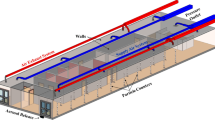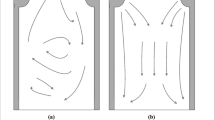Abstract
As infectious respiratory diseases are highly transmissible through the air, researchers have improved traditional total volume air distribution systems to reduce infection risk. Multi-vent module-based adaptive ventilation (MAV) is a novel ventilation type that facilitates the switching of inlets and outlets to suit different indoor scenarios without changing ductwork layout. However, little research has evaluated MAV module sizing and air velocity selection, both related to MAV system efficiency in removing contaminants and the corresponding level of protection for occupants in the ventilated room. Therefore, the module-source offset ratio (MSOR) is proposed, based on the MAV module size and its distance from an infected occupant, to inform selection of optimal MAV module parameters. Computational fluid dynamics simulations illustrated contaminant distribution in a two-person MAV equipped office. Discrete phase particles modelled respiratory contaminants from the infected occupant, and contaminant concentration distributions were compared under four MAV air distribution layouts, three air velocities, and three module sizes considered using the MSOR. Results indicate that lower air velocities favour rising contaminant levels, provided the ventilation rate is met. Optimal contaminant discharge can be achieved when the line of outlets is located directly above the infected occupant. Using this parameter to guide MAV system design, 85.7% of contaminants may be rendered harmless to the human body within 120 s using the default air vent layout. A more appropriate supply air velocity and air vent layout increases this value to 91.4%. These results are expected to inform the deployment of MAV systems to reduce airborne infection risk.
Similar content being viewed by others
Abbreviations
- C :
-
location of contaminant source (x, y)
- C e :
-
averaged tracer-gas or particle concentration at the two exhausts (ppm)
- C p :
-
particle concentration at the measured location (ppm)
- C s :
-
particle concentration at the air supply inlet (ppm)
- G s :
-
supply airflow rate (m3/s)
- L :
-
length of line connecting two adjacent air vents (m)
- MSOR :
-
module source offset ratio (—)
- O :
-
centre point of MAV module air vents (0, 0)
- R c :
-
particle release rate
- s :
-
largest offset of the source from the origin (m)
- x :
-
distance from C to x-axis
- y :
-
distance from C to y-axis
- ε :
-
dimensionless particle concentration (—)
References
Bauman F, Webster T (2001). Outlook for underfloor air distribution. ASHRAE Journal, 43(6): 18–27.
Boyle R (1899). Natural and Artificial Methods of Ventilation, London: Robert Boyle & Son, Ltd.
Cao G, Nielsen PV, Jensen RL, ET AL. (2015). Protected zone ventilation and reduced personal exposure to airborne cross-infection. Indoor Air, 25: 307–319.
Gupta JK, Lin C-H, Chen Q (2010). Characterizing exhaled airflow from breathing and talking. Indoor Air, 20: 31–39.
Karimipanah T, Awbi HB (2002). Theoretical and experimental investigation of impinging jet ventilation and comparison with wall displacement ventilation. Building and Environment, 37: 1329–1342.
Kutter JS, Spronken MI, Fraaij PL, et al. (2018). Transmission routes of respiratory viruses among humans. Current Opinion in Virology, 28: 142–151.
Lin Z, Chow TT, Tsang CF, et al. (2009). Stratum ventilation—A potential solution to elevated indoor temperatures. Building and Environment, 44: 2256–2269.
Melikov AK (2004). Personalized ventilation. Indoor Air, 14: 157–167.
Melikov AK (2011). Advanced air distribution. ASHRAE Journal, 53(11): 73–77.
Melikov AK (2016). Advanced air distribution: Improving health and comfort while reducing energy use. Indoor Air, 26: 112–124.
Morawska L, Cao J (2020). Airborne transmission of SARS-CoV-2: The world should face the reality. Environment International, 139: 105730.
Morawska L, Johnson GR, Ristovski ZD, et al. (2009). Size distribution and sites of origin of droplets expelled from the human respiratory tract during expiratory activities. Journal of Aerosol Science, 40: 256–269.
Müller D, Kandzia C, Kosonen R, et al. (2013). Mixing ventilation. Guide on mixing air distribution design. REHVA: Federation of European Heating and Air-conditioning Associations.
Nielsen PV (2009). Control of airborne infectious diseases in ventilated spaces. Journal of the Royal Society, Interface, 6: S747–S755.
Nielsen PV, Olmedo I, de Adana MR, et al. (2012). Airborne cross-infection risk between two people standing in surroundings with a vertical temperature gradient. HVAC&R Research, 18: 552–561.
Olmedo I, Nielsen PV, Ruiz de Adana M, et al. (2013). The risk of airborne cross-infection in a room with vertical low-velocity ventilation. Indoor Air, 23: 62–73.
Owen MS (2009). ASHRAE Handbook: Fundamentals, Atlanta: American Society of Heating, Refrigeration, and Air-Conditioning Engineers.
Pantelic J, Tham KW, Licina D (2015). Effectiveness of a personalized ventilation system in reducing personal exposure against directly released simulated cough droplets. Indoor Air, 25: 683–693.
Pascal PH, Oesterlé B (2000). On the dispersion of discrete particles moving in a turbulent shear flow. International Journal of Multiphase Flow, 26: 293–325.
Sehulster LM, Chinn RYW, Arduino MJ, et al. (2003). Guidelines for Environmental Infection Control in Health-care Facilities: Recommendations from CDC and the Healthcare Infection Control Practices Advisory Committee (HICPAC). Chicago: American Society for Healthcare Engineering/American Hospital Association.
Skistad H, Mundt E, Nielsen PV, et al. (2002). Displacement Ventilation in Non-industrial Premises. PREHVA Guidebook No. 1. REHVA: Federation of European Heating and Air-conditioning Associations.
Wei X, Yi D, Xie W, et al. (2021). Protection against inhalation of gaseous contaminants in industrial environments by a personalized air curtain. Building and Environment, 206: 108343.
Xu Y, Cao C, Ma M, et al. (2022). Direction air supply design and optimization in industrial settings to reduce gaseous contaminant exposure. Building and Environment, 216: 109003.
Yao T, Lin Z (2014). An experimental and numerical study on the effect of air terminal layout on the performance of stratum ventilation. Building and Environment, 82: 75–86.
Yin Y, Gupta JK, Zhang X, et al. (2011). Distributions of respiratory contaminants from a patient with different postures and exhaling modes in a single-bed inpatient room. Building and Environment, 46: 75–81.
Yin H, Li A, Liu Z, et al. (2016). Experimental study on airflow characteristics of a square column attached ventilation mode. Building and Environment, 109: 112–120.
Zhang C, Heiselberg P, Nielsen PV (2014). Diffuse ceiling ventilation—A review. International Journal of Ventilation, 13: 49–64.
Zhang R, Li Y, Zhang AL, et al. (2020). Identifying airborne transmission as the dominant route for the spread of COVID-19. Proceedings of the National Academy of Sciences, 117: 14857–14863.
Zhang H, Zhang W, Zhang W, et al. (2022). Multi-vent module-based adaptive ventilation to reduce cross-contamination among indoor occupants. Building and Environment, 212: 108836.
Acknowledgements
This work was supported by the National Natural Science Foundation of China [No. 52078009]; the special fund of Beijing Key Laboratory of Indoor Air Quality Evaluation and Control [No. BZ0344KF20-05]; and the joint research project of the Wind Engineering Research Center, Tokyo Polytechnic University (MEXT (Japan) Promotion of Distinctive Joint Research Center Program) [No. JPMXP0619217840, No. JURC 20202007].
Author information
Authors and Affiliations
Contributions
Conceptualization: Haotian Zhang, Weijia Zhang; methodology: Haotian Zhang; validation: Haotian Zhang; visulaization: Haotian Zhang; data curation: Xiaoxiao Ding; project administration: Weirong Zhang; writing—original draft preparation: Haotian Zhang; writing—review and editing: Weirong Zhang; funding acquisition: Weirong Zhang, Yingli Xuan; wupervision: Weirong Zhang.
Corresponding author
Ethics declarations
Declaration of competing interest
The authors have no competing interests to declare that are relevant to the content of this article.
Ethical approval
This study does not contain any studies with human or animal subjects performed by any of the authors.
Rights and permissions
About this article
Cite this article
Zhang, H., Ding, X., Zhang, W. et al. Optimising multi-vent module-based adaptive ventilation using a novel parameter for improved indoor air quality and health protection. Build. Simul. 17, 113–130 (2024). https://doi.org/10.1007/s12273-023-1063-8
Received:
Revised:
Accepted:
Published:
Issue Date:
DOI: https://doi.org/10.1007/s12273-023-1063-8




